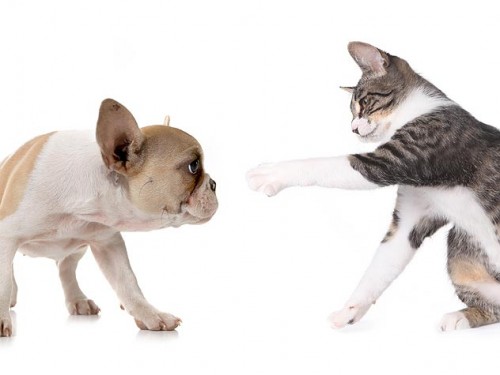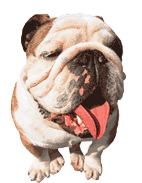My Dog Chases My Cat. How Do I Stop Him?
THE FOLLOWING IS AN EXCERPT FROM PETFINDER.COM’S FURKEEPS KICKOFF LIVE FACEBOOK Q&A.
Q: I have a 2-year-old male Dachshund/Pug mix and in the last four months he has decided that my four cats are perfect for chasing. He has two other dogs to play with, gets plenty of exercise, and still chases my cats. What am I missing? I know doxis have high prey drives, but why did he start chasing the cats in only the last four months?
A: It’s hard to say why you are suddenly seeing this chasing behavior when you never did before. I assume all the cats were residents before your dog got there? Be sure your dog’s exercise regimen is regular and very exhausting. Exercise can often solve a great many issues right off the bat!

There is some inherent reward in the chase behavior, so the more your dog does it, the more well-versed he will become. This can become very serious, so being consistent in redirection and correction of this behavior before it starts over the next few weeks will really be important.
That said, I would also correct him if he gets fully into chase mode because you were not able to catch him in time to redirect him first. If he takes off chasing, you need to be right after him, using your voice as a correction tool. I want him to be immediately aware he has made a bad choice in chasing the kitty because Mom is very upset.
When you catch him, without emotion, put him into a room by himself or into his crate for a few minutes. You don’t need to hold a long grudge against him, but he needs to know that his chasing behavior has a serious consequence. Not only will you not allow it, he will have some time alone if and when he partakes.
If you have done any obedience work with him, use your recall (come, here, etc.) to work on calling him off. You may want to review his recall in contexts easier than cat-chasing at first so you can build a reinforcement history for coming when called. That way, you are likely to be more successful when he is otherwise distracted. This practice will help you outdoors as well with his daily recalls or off-leash behavior.
If you ever taught him a reliable “leave it” command, you can use that in this instance as well. Realistically, this takes lots of practice. He should be practicing lots of “leave its” in other contexts to help him understand what is expected of him so he has the best chance for success with the cat situation.
Always reward calm behavior in the presence of the cats. Any time they walk in and your dog is calm, reward like crazy with tasty tiny treats. This will help him make a nice, positive association with the presence of the cats. It will also help him learn to look to you when the cats are around rather than making his own choices about how best to deal with the cats!
I tend to be a little harsh with cat chasing as I have seen it turn into serious predatory behavior very fast — hence my suggestion for corrective measures in conjunction with the praise and reward for any good behavior that happens along the way!
Good luck!
Leslie Burgard
Dogs Think! Dog Training
Furnace, PA
Q: I have a 1-year-old Lab mix who is constantly chasing my cats. They hide in their little room all the time because they’re scared of him. Occasionally he’s jumped on them and pinned them down. He’s fine with the ferrets. Is there any way to stop this?
A: You can certainly suppress this behavior and eliminate it from your dog’s repertoire. The key is not to allow the dog to practice the behavior.
Chasing is very self-reinforcing for dogs. Basically, it is innately reinforcing. When I work with dogs and cats, I put the dog on a very strict training program, making sure the dog can recall away from any distraction. The dog must also be crated to give the cats time to wander. Lastly, the dog should be wearing a drag line so you can stop him from chasing the cats.
Supervision is critical. You can begin by having the cat in a carrier and permit the dog to be close (not too close) to the cat. Call your dog off the carrier and reward him with something he never gets, but loves. He needs to understand that coming to you is worth his while. Also, if he retrieves, I reward with a retrieve — in other words, I am putting the dog in chase mode, but chasing after the correct object.
Information on Dental Care for Dogs

Other preventive measures include providing dogs with toys and treats that have a tartar-removing effect. These include hard rubber chew toys with hollow interiors that can be stuffed with treats, as well as rope or sheepskin toys, which have fibers that help keep teeth clean.
Periodontal Disease
If a dogs teeth aren’t cared for, the result is sure to be periodontal disease, the most common dental condition affecting dogs. Periodontal disease is the inflammation and infection of the gums and supporting tissues of the teeth. It begins when bacteria-laden plaque and tartar (calculus) build up on teeth, especially below the gum line. Pockets form under the gum line and food lodges in the pockets. These bits of food that remain on teeth are breeding grounds for bacteria. The resulting infection causes bad breath, bleeding and inflammation of the gums, receding gums, loosening of teeth, and eventual tooth loss.
According to the American Veterinary Dental Society, more than 80 percent of dogs over the age of three years develop gum or periodontal disease. Any dog can develop periodontal disease, but its seen most commonly in toy breeds. They have the same number of teeth (42) as larger dogs, but the teeth are crowded into a smaller area. Regular brushing is the best way to get rid of food residue so it doesn’t harden and form the ugly brown deposits known as tartar.
Routine periodontal treatment performed by a veterinarian typically includes ultrasonic scaling, subgingival manual scaling, and polishing. For advanced cases of periodontal disease, some dental specialists use antibiotic therapy, which involves cleaning and polishing the teeth, regular home brushing, and administering antibiotics for the first five days of every month. This regimen decreases the progression of the disease. Another new treatment is Doxyrobe, a gel placed inside the socket to sterilize it. This sustained-release form of doxycycline is used in periodontal pockets to increase attachment. If the dogs teeth are in really bad shape, periodontal surgery such as bone grafting and guided tissue regeneration can be performed. For the most severe cases, extraction is the only option.
Endodontic Conditions
These conditions involve broken or abscessed teeth that require root canals or extractions. Endodontic problems are most common in large dogs, especially shepherd and retriever breeds. These dogs chew a lot on such things as fences, cow hooves, and bones, wearing their teeth down and sometimes breaking them. Even chewing on ice cubes can cause teeth to fracture.
Dental fractures are common in dogs, and treatment is a must if the pulp, the soft tissue that fills the center of a tooth, is exposed. This is not only painful, but it can also lead to tissue death and abscess. A root canal is the preferred method of treatment for such cases, although occasionally extraction may be the best choice.
Don’t ignore a broken tooth, even if it doesn’t seem to bother the dog. The majority of dogs are happier and more active once a tooth repair is made.
Oral Surgery
Oral surgery is done usually to remove teeth or repair fractured jaws. Extractions are performed with minimal pain and discomfort, and jaw fractures can be repaired using new techniques that minimize damage to teeth and ensure a rapid return to normal function.
Dogs may also need oral surgery when they’re diagnosed with tumors of the mouth and throat, which are common in dogs. Radiotherapy and recently developed surgical techniques for removing oral tumors are now available. These techniques often give excellent results, both in terms of cosmetic appearance and prognosis, provided they are applied at an early stage of the disease.
Examine your dogs mouth monthly. Oral tumors can go unnoticed until they’ve reached an advanced stage of development, making successful treatment more difficult. Bring any suspicious swellings or persistent sores to the attention of your veterinarian. Besides oral tumors, dogs can also develop noncancerous masses and swellings such as gingival hyperplasia.





